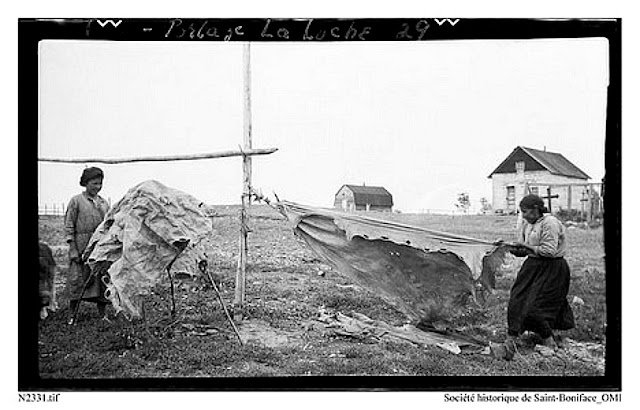 |
Father Bertrand Mathieu and his dog team in 1955 La Loche. The Mission of La Loche included La Loche, Garson Lake, Descharme Lake, Turnor Lake, Bull's House and West La Loche. Visiting these small villages regularly was Father Mathieu's responsibility. (Photos from Canada Archives)
|
Saturday 25 August 2012
Father Mathieu's dog team 1950's La Loche
Wednesday 22 August 2012
"The Great Portage" 1950's La Loche.
La Loche in the 1950's as shown in the writings of the missionaries and the students of the school.
In this issue of "The Great Portage" in 1959, a La Loche community newsletter: The church gets electricity. The school gets a new furnace. There is a plane crash in Garson Lake. There are weddings and births. There are TB clinics. A road is getting built to the village. (downloaded from: http://archives.algomau.ca/drupal6/search/apachesolr_search/la%20loche)
In this issue of "The Great Portage" in 1959, a La Loche community newsletter: The church gets electricity. The school gets a new furnace. There is a plane crash in Garson Lake. There are weddings and births. There are TB clinics. A road is getting built to the village. (downloaded from: http://archives.algomau.ca/drupal6/search/apachesolr_search/la%20loche)
Sunday 19 August 2012
Ice fishing in Patuanak 1940's
 |
| http://www.jkcc.com/fishfur.html |
"FISHING A SPORT?--NOT HERE
Fishing in winter can hardly be considered a sport. It
is rather hard work which deserves better than an 8 cent
cheque after a season of it." (written in 1947 by a student of Ile a la Crosse School)
Tanning moose hide in 1947
"FROM MOOSE TO MOCASSINS"
"Last summer while I was staying at Pachuanak with my father, I was interested in
watching the women transform a moose's hide into beaded moccasins.
This is how they did it." (written in 1947 by a student of Ile a la Crosse School)
"The men had killed a moose - a rare event these past years -- and brought the hide home to their women who immediately soaked it in a tub of water so that it would not harden before they worked on it. The men also made a frame with four poles -- and their task was ended."
upright against 2 trees. With a sharp bone, they scraped off the fur on one side,
the flesh from underneath and let it stand for a night."
The next day they removed the hide from the frame and rubbed it on both sides with the brains of the moose which the men had saved. This takes
the place of oil, I was told. It was then left to dry in the sun for a few days.
When it was dry, they soaked it again in water to soften it.
They took the hide to the bush, hung it over a
strong branch, and wrung it with a stick, turning it over
and over until not a drop of water could be squeezed out of it.
While the skin was drying, the women scraped it and beat it with covers of
pails to make it fuzzy and soft on both sides. It was now ready to be tanned.
They sewed the skin together lengthwise, leaving both ends open.
With three sticks they built a tepee, suspended the skin inside
and made a fire with rotten wood directly beneath it.
The smoke which curled in and out of the roll of skin, tanned it to a golden color.
Finally they cut out the mocassins according to a simple pattern of their own.
Some sewed on the colored beads , scarce and expensive since the war,
while others embroidered the floral designs which they
had traced on the skin with a little stick dipped in a red
solution made with a piece of crepe paper.
What patient labour it required -- definitely a woman's work"~
Florence Ahenakew (IX)
 |
"They took the hide to the bush, hung it over a strong branch, and wrung it with a stick, turning it over and over until not a drop of water could be squeezed out of it."
(La Loche circa 1944) |
 |
| (La Loche circa 1944) |
Florence Ahenakew was a grade 9 student at Ile a la Crosse School in 1947 when she wrote this story. She was born on June 7, 1929. Her father was Alexander Ahenakew, the H.B.C. post manager of the Pine River Post .....read more
Copied from 'Island Breeze' ....December 1947 (Ile a la Crosse newspaper)
The black and white photos on this page were taken in the 1940's in La Loche, Saskatchewan.
Read more......http://www.native-art-in-canada.com/braintanning.html
 |
The boy is Robert Guetre (1940?). Elizabeth (Robert's mother) is the lady on the left. Father Ducharme on the left. Isabelle (Velner) Janvier (grandmother of Pauline (Janvier) Fontaine)
|
Beauval Residential School Yearbooks
.JPG) |
| View the complete 1968 yearbook at the following link. 1968 Beauval Residential School Yearbook Residential Schools in Canada |
Saturday 18 August 2012
La Loche Education 1944
Friday 17 August 2012
Buffalo River, Saskatchewan 1908
 |
| Part of the Buffalo River series; This photo was mislabelled as having been taken in Buffalo Narrows.
Frank J. P. Crean's photos of Buffalo River (Dillon), Saskatchewan.
These were taken in September 1908. Dillon is on the western shore of Peter Pond Lake.
These five photos were all taken at the same location at Buffalo River. Buffalo River would later be known as Dillon (a name change took place after 1929).
http://en.wikipedia.org/wiki/Dillon,_Saskatchewan |
Thursday 16 August 2012
Blue-green algae in Lac La Loche
| St. Bernard dog on the shore of Lac La Loche. This dog died after drinking water from the lake. read more....blue-green-algae-can-be-fatal-to-pets read more..............summer-perils-blue-green-algae |
Subscribe to:
Posts (Atom)




